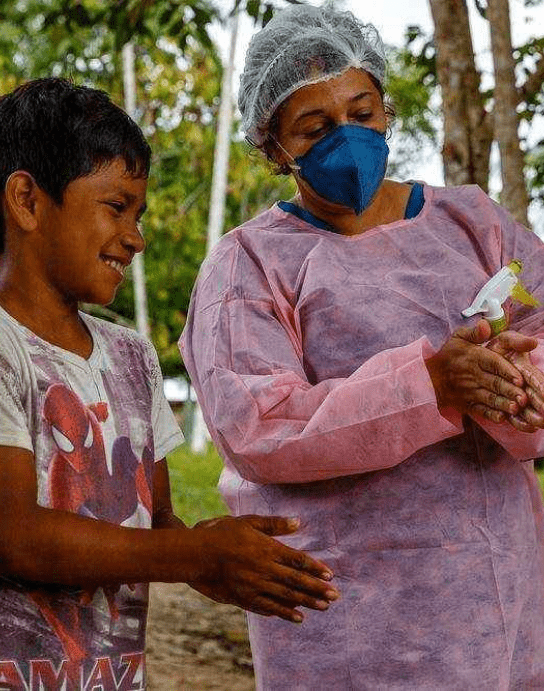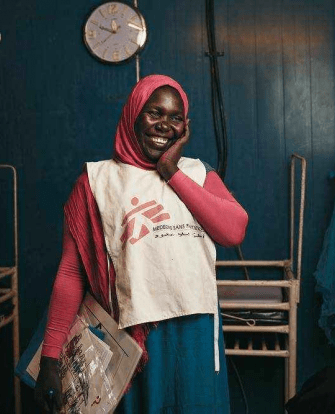
Liberia 2014 © John Moore/MSF
Ebola
Ebola is rare but deadly, spreading fear and panic. Caring for infected patients and affected communities is crucial for a response to be effective.
MSF study: Ebola vaccine cuts mortality figures in half for people infected with the virus
February 9, 2024–A new Doctors Without Borders/Médecins Sans Frontières (MSF) study published in The Lancet Infectious Diseases shows, for the first time, that being vaccinated—even after being exposed to the Ebola virus—can cut mortality figures of those infected in half. The observational study was conducted by MSF’s research arm, Epicentre, and focuses on the rVSVΔG-ZEBOV-GP vaccine—produced by Merck under the name Ervebo—during the 2018-2020 Ebola epidemic in the Democratic Republic of Congo (DRC).
Read more
Putting Ebola in context
The Ebola virus can kill anywhere from 25 percent to 90 percent of people who become infected, causing terror among affected communities. MSF has intervened in most Ebola epidemics, including the largest one ever documented—in West Africa from 2014 to 2016. We most recently responded to a massive Ebola outbreak in Democratic Republic of Congo (DRC), the worst to hit that country and the second largest outbreak on record. No cure exists, but a promising new vaccine and several still-experimental treatments are bringing hope in the battle against this deadly disease.
people died
during the 2014-2016 Ebola epidemic
outbreaks
in 40 years
people received
the Ervebo Ebola vaccine during the 2018-2020 outbreak in DRC
Facts about Ebola
Ebola is caused by a virus transmitted between humans or to humans from animals. In Africa, people have developed Ebola after handling infected animals found ill or dead, including fruit bats. There are five different strains of Ebola virus, named after where they were discovered: Bundibugyo, Ivory Coast, Reston, Sudan, and Zaire.
Human-to-human transmission occurs through contact with bodily fluids of an infected person, including blood and secretions. For this reason, health care staff and all others in contact with an infected person must wear properly designed protective clothing to avoid becoming infected.
In pregnant women, the virus may be transmitted from mother to baby in utero, during delivery, or through contact with maternal body fluids (including breast milk) after birth.
Ebola is not spread through air or water, or from newly infected people who are not yet showing any symptoms.
During an outbreak, Ebola virus can spread quickly within health care facilities. Proper infection control in health centers is therefore vital to reduce risks for other patients, caregivers, and health workers. Those caring for infected patients must wear personal protective equipment (PPE). Protective gear must be also worn to safely bury Ebola victims, as the virus can be transmitted by touching the bodies of those who have died from the disease.
Symptoms appear any time from 2 to 21 days after exposure to the virus, typically in 8 to 10 days. Ebola usually begins with a sudden onset of fever, weakness, muscle pain, headache, and sore throat. This is often followed by vomiting, diarrhea, and abdominal pain, which may progress to severe disease with altered mental status, shock, multi-organ failure, and sometimes abnormal bleeding. Other symptoms may include red eyes, hiccups, chest pains, and difficulty breathing and swallowing.
The early, non-specific symptoms of Ebola are also common to other serious diseases, including malaria and typhoid fever, and to symptoms of pregnancy complications. For this reason, laboratory testing is essential to identify infected patients and to help ensure that people who test negative for Ebola receive correct diagnosis and treatment for their symptoms.
Ebola is diagnosed by tests that detect the genetic material of the virus. Until recently, these tests required highly trained technicians working in well-equipped laboratories that were often far from outbreak zones. This meant that patients and health workers often waited days for Ebola test results.
In the current Ebola outbreak in DRC, this waiting time has shrunk to hours—thanks to a new test developed towards the end of the West African epidemic. Equipped with a small machine called GeneXpert, which is already widely used to diagnose other infections such as tuberculosis, simpler Ebola tests are now being performed rapidly and close to transmission zones.
One caveat is that many patients may test negative for the first few days of symptoms, so a negative Ebola test needs to be repeated after 72 hours if Ebola is strongly suspected.
Once a case of Ebola is confirmed, a swift response is vital to contain an outbreak. The needs of patients and affected communities must remain at the heart of the response.
The essential measures for containing outbreaks, which are all necessary for effective control, are:
- Care and isolation of patients, to prevent further spread and save lives;
- Community engagement and health promotion, to build community understanding of Ebola and participation in implementing necessary interventions;
- Environmental decontamination (such as spraying homes of patients) and safe, dignified burials of those who died from Ebola;
- Surveillance of affected and at-risk communities, to identify possible cases early;
- Contact tracing, to find and test anyone who had recent contact with a new Ebola patient;
- Supporting existing health structures to identify and refer potential Ebola patients and to maintain effective infection control; and
- Vaccination.
Once an outbreak has ended, it’s critical to maintain surveillance for Ebola in the region, so that any new patient is quickly identified before another outbreak flares up. Another key measure is to support at-risk countries in developing preparedness plans.
Towards the end of the West Africa outbreak, trials for a new vaccine began, and by late 2016 had shown promising evidence that the vaccine was both safe and effective against the Zaire strain of Ebola virus. This vaccine, known as rVSV-ZEBOV, is now being used in responding to the ongoing Ebola outbreak in DRC. But for several reasons, including not having official licensure for the vaccine, it must be used under very restrictive conditions that severely limit the speed, and therefore the reach, of vaccination efforts.
Without proven, effective treatments specific to Ebola, until recently treatment has been limited to supportive therapies, starting with medications to reduce pain, fever, vomiting, and diarrhea. Other treatments focus on hydration: Since patients lose so much fluid, keeping them hydrated is crucial to avoiding shock and other severe consequences. If patients are alert, able to participate in their care, and are not vomiting, oral rehydration drinks can be sufficient to replenish fluids. Those with severe diarrhea or vomiting, or who cannot drink enough liquid, receive intravenous fluids. Anti-anxiety drugs can also help patients in distress, while vitamins and therapeutic foods are also provided. Psychological support is also provided to help patients and their families cope with a frightening, serious illness, often while simultaneously facing the illness or loss of other family members from Ebola.
But this limited set of tools may soon expand. Four investigational drugs are now being utilized in the DRC outbreak, both as part of a clinical trial and under "compassionate care" protocols (although not all treatments are available at all Ebola treatment centers). They fall into two categories: direct antiviral drugs and immune therapies based on monoclonal antibodies to Ebola. Each of these treatments has distinct advantages and disadvantages involving ease of use and feasibility (injection or slow infusion; frequency of treatment needed; refrigeration requirements). Patients and families are counseled that their effectiveness is not yet proven prior to signing consent for use.

How MSF responds to Ebola
An effective Ebola response demands a series of interventions, all of which are crucial to containing outbreaks. They include care and isolation of patients and finding (and isolating) new patients; avoiding transmission through safe, dignified burial of Ebola victims and through decontamination of ambulances, patients’ homes, and health facilities at risk; engaging with affected and at-risk communities; and supporting health facilities that provide care for illnesses other than Ebola. Very recently, vaccination might become another important step.
More Ebola news and stories
Learn about MSF’s journalistic roots and our commitment to bear witness and speak out about the plight of the people we treat.

News Oct 17, 2024
Time for $5: Over 200,000 people support MSF’s call for Danaher to mak...
Read MoreLearn about MSF’s journalistic roots and our commitment to bear witness and speak out about the plight of the people we treat.





